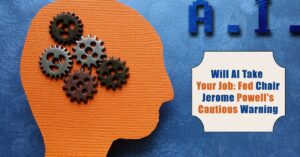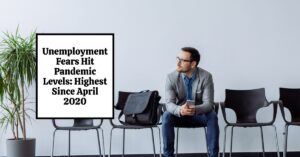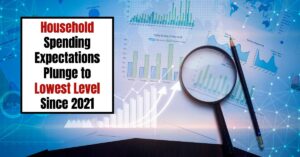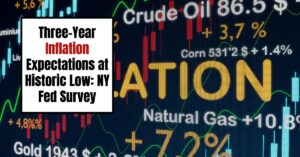Is artificial intelligence (AI) poised to steal our jobs? That's the burning question on many minds, and Federal Reserve Chair Jerome Powell has weighed in. While the full impact remains uncertain, Powell warns that AI will make “significant changes” to the economy and labor market, potentially displacing jobs before creating new opportunities. So, it's not a simple yes or no, but rather a complex shift we need to understand and prepare for.
The rise of AI isn't just some sci-fi fantasy anymore; it's rapidly becoming a reality across various industries. We're seeing AI tools automating tasks once done by humans, from writing articles to analyzing data. But what does this mean for our future work prospects? Are we all destined to be replaced by robots? Let's dive into what Powell said and what others in the industry are observing.
Will AI Take Your Job: Fed Chair Jerome Powell's Cautious Warning
Powell's Cautious Warning: AI is Coming, But When and How?
During a recent testimony before the Senate Banking Committee, Fed Chair Jerome Powell acknowledged AI's potential to reshape the workforce. He noted that while the impact to date is “probably not great,” significant changes are on the horizon.
Here's a breakdown of Powell's key points:
- Limited Current Impact: Powell stated that AI's effects on the job market haven't been substantial yet.
- Potential for Job Displacement: He cautioned that in the initial stages, AI could “replace a lot of jobs, rather than just augmenting people's labor.” This means we might see some industries experience job losses before new AI-related positions emerge.
- Uncertain Timeline and Consequences: Powell emphasized that the timing and magnitude of AI's impact remain uncertain. It's hard to predict exactly when we'll see these changes and what they'll look like.
- Long-Term Optimism: Despite the potential for job displacement, Powell expressed optimism about AI's long-term potential to enhance productivity and create greater employment opportunities. He thinks, just like many people, that AI will create new opportunities down the road.
Powell's remarks were sparked by concerns raised by lawmakers about AI's potential to eliminate jobs. Senator Lisa Blunt Rochester cited Anthropic CEO Dario Amodei's prediction that AI could wipe out up to 50% of entry-level white-collar jobs within five years, potentially leading to a 10-20% increase in unemployment. That's a scary thought, but as Powell pointed out, it's still an “open question” how big AI's impact will be and how fast it will happen.
Beyond Powell: Industry Leaders Echo Concerns and Highlight Real-World Impacts
It's not just Powell sounding the alarm. Other industry leaders are seeing the effects of AI firsthand. Here's what some of them are saying:
- Dario Amodei (Anthropic CEO): As mentioned earlier, Amodei believes AI could disrupt up to 20% of the broader labor force, significantly impacting entry-level roles.
- Marc Benioff (Salesforce CEO): Benioff revealed that AI is already performing 30 to 50% of the work at Salesforce, leading to expectations of ongoing workforce reductions and productivity gains in areas like engineering, coding, and support.
- BT (UK Telecommunications Company): BT plans to cut its workforce by 42% (approximately 55,000 jobs) by 2030, with AI potentially enabling even greater reductions. This shows companies are seriously considering AI as a means to cut costs and increase efficiency.
Real World Examples of AI Impact
| Source | Insight |
|---|---|
| Jerome Powell (Fed Chair) | AI's current impact is limited but could cause significant job market changes. |
| Recent Study | AI is not yet replacing jobs or depressing wages significantly. |
| BT (UK Telecom) | Plans to cut 42% of workforce (55,000 jobs) by 2030, with AI enabling more cuts. |
| Anthropic CEO Dario Amodei | AI could eliminate 50% of entry-level white-collar jobs in 5 years. |
| Salesforce CEO Marc Benioff | AI handles 30-50% of Salesforce's work, leading to workforce reductions. |
These examples highlight that we're not just talking about hypothetical scenarios. AI is already impacting the job market in tangible ways. Companies are using AI to automate tasks, reduce their workforce, and increase productivity.
What Can the Fed Do? The Limits of Monetary Policy
While the Federal Reserve plays a crucial role in the economy, Powell admitted that the Fed has limited tools to address the challenges posed by AI-driven labor market disruptions. He stated that the Fed's primary tool – interest rates – is not designed to tackle the complexities of technological change.
The Fed's main focus is on maintaining stable prices and maximum employment. But if AI causes widespread job displacement, it could be difficult for the Fed to achieve its employment goals. This underscores how AI brings in complex elements, such as unemployment.
This means that other solutions are needed. Powell suggests that broader policy interventions involving Congress, industry leaders, and labor experts are necessary to help workers adapt to AI and ensure a smooth transition.
So AI will take my job?
Well, I can't say it certainly won't. However, I think this situation needs to be viewed as an opportunity. Here's a balanced view.
The Pessimistic View
- Job Loss: Automation through AI can lead to significant job losses, particularly in roles involving repetitive tasks. This could mean displacement for workers in sectors like manufacturing, data entry, and even customer service.
- Skills Gap: The skills required in the future workforce will likely be heavily tech-focused, potentially leaving many workers with outdated skills behind. Those who aren't tech-savvy may find themselves at a disadvantage.
- Wage Stagnation: Increased automation and a surplus of available workers could lead to lower wages, especially for those in lower-skilled positions. Companies could have more leverage to pay less as demand for labor decreases.
The Optimistic View
- New Job Creation: AI is expected to create new types of jobs, particularly in fields like AI development, data science, and AI maintenance. The demand for professionals who can build, manage, and troubleshoot AI systems is likely to grow.
- Increased Productivity: AI can assist workers, making them more productive and efficient. This could lead to economic growth and higher overall living standards.
- Better Work Conditions: Automation can take over mundane and dangerous tasks, freeing up workers for more creative and fulfilling work. Workers can focus on strategy, innovation, and customer relations, improving job satisfaction.
- Enhanced Innovation: AI can analyze vast amounts of data to uncover new insights and drive innovation across various industries. This could lead to breakthroughs in healthcare, transportation, and other fields, creating more opportunities.
Policy Considerations: Adapting to the AI Revolution
As AI continues to evolve, policymakers are starting to think about the right strategies to adapt.
- Upskilling and Reskilling: Investing in upskilling and reskilling programs to help workers acquire the skills needed for AI-related jobs is critical. This could involve government-funded training programs, partnerships with educational institutions, and industry-led initiatives.
- Four-Day Workweek: Some lawmakers are exploring the possibility of a four-day workweek to address potential job displacement and promote work-life balance.
- Regulatory Frameworks: Developing regulatory frameworks to ensure that AI is used ethically and responsibly is also important. This could involve regulations around data privacy, algorithmic transparency, and bias detection.
- Social Safety Net: Strengthening social safety nets, such as unemployment benefits and job placement services, can help workers transition between jobs and provide support during periods of unemployment.
My Take on the Situation
Well, I believe that AI is going to have a profound impact on the job market. While there are definitely reasons to be concerned about job displacement, I also see a lot of potential for AI to enhance our lives and create new opportunities.
I believe that AI will initially have a more disruptive effect in the short term, particularly for routine-based, automatable tasks. However, in the long run, once the technology becomes more widespread and roles have been redefined, AI has the potential to create new jobs by increasing overall organizational productivity and efficiency.
The key is to be proactive. We need to invest in education and training to ensure that workers have the skills they need to thrive in the AI-driven economy. We also need to create policies that support workers during this transition and ensure that the benefits of AI are shared broadly.
Ultimately, the future of work in the age of AI depends on how we choose to shape it. By working together, we can ensure that AI enhances rather than undermines the workforce.
Future-Proof Your Wealth—Even Amid AI Disruption
As AI transforms industries and raises job uncertainty, investing in real estate offers a stable path to income and security.
Norada connects you to turnkey rental properties that generate consistent cash flow—helping you build resilient wealth regardless of economic shifts.
HOT NEW LISTINGS JUST ADDED!
Talk to a Norada investment counselor today (No Obligation):
(800) 611-3060
Read More:
- US Dollar Plummets to 3-Year Low: What It Means for Your Wallet
- US-Iran War: A New Threat to America's Shaky Economy
- Bond Market Today and Outlook for 2025 by Morgan Stanley
- The Risk of New Tariffs: Will They Crash the Stock Market and Economy?
- Stagflation Alert: Economist Survey Predicts Weak Q1 GDP Due to Tariffs
- Goldman Sachs Significantly Raises Recession Probability by 35%
- 2008 Crash Forecaster Warns of DOGE Triggering Economic Downturn
- Stock Market Crash Prediction With Huge Discounts on Bitcoin, Gold, Houses
- Stock Market Predictions for the Next 5 Years
- Is the Bull Market Over? What History Says About the Stock Market Crash
- Wall Street Bear Predicts a Historic Stock Market Crash Like 1929





